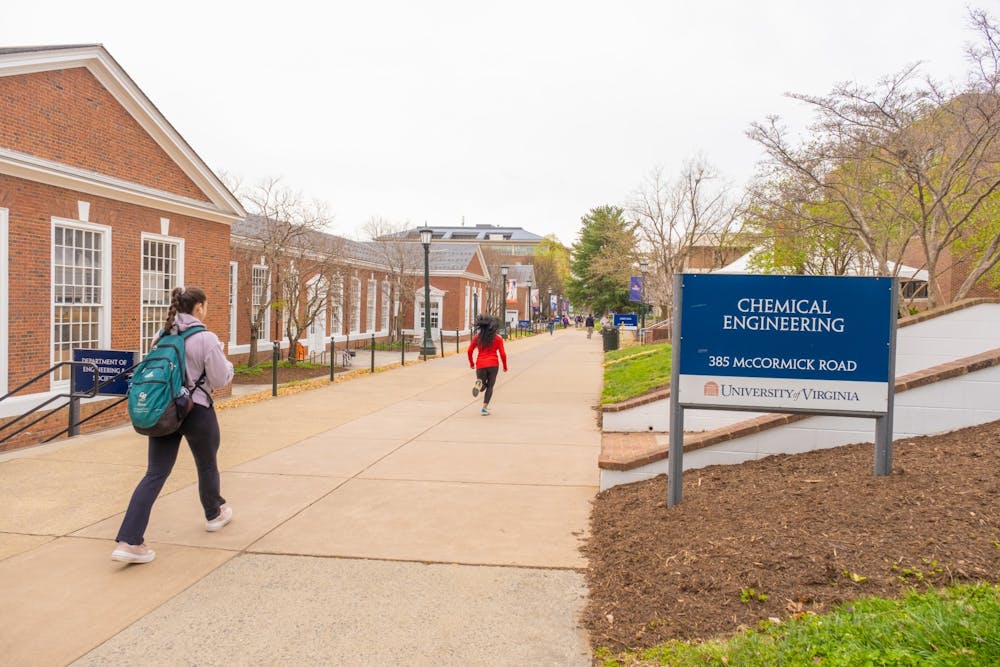While 56 percent of University students identify as women, only 33.6 percent of the School of Engineering and Applied Science’s student body is female. Alongside national initiatives to encourage women entering STEM fields, SEAS has seen increases in the numbers of women admitted in the past admissions cycle, along with student efforts to promote female representation both within the school and in the larger Engineering community.
Swathi Shekharan, third-year Engineering student and president of Engineering Student Council, said her major, Biomedical Engineering, is the only concentration with majority female students. She said that the environment of both more female students and female teachers has supported her learning experience.
“No one wants to feel like their voice doesn't matter as much or that they're not getting representatives,” Shekharan said. “I do think that increasing the representation of women just in general, especially within our professors and our administration, is the best way to improve the experience of women in school.”
While the University’s overall spring admissions cycle acceptances were 57.7 percent women, SEAS acceptances were 39 percent women — an increase from 37 percent last year. This admission cycle reflects a small increase in female representation, given that the current SEAS student body is 33.6 percent female.
Anne Kromkowski, senior associate dean and chief operating officer, said SEAS cites diversity as a core value. According to Society of Women Engineers data, SEAS’s tenured and tenure-track faculty is 23 percent women, compared to a national average of 19.2 percent.
“Our women faculty are world-class researchers and teachers,” Kromkowski wrote in a statement to the Cavalier Daily. “These role models are one of the reasons that U.Va. Engineering is the top U.S. public engineering school for percentage of women graduates.”
Nationally, only around 22 percent of engineering degrees are awarded to women. SEAS saw a slight reduction in offers made — from 1,975 in 2022 to 1,882 in 2023 — but the number of female engineering students increased from 727 to 734.
Although many female students reported overall satisfaction with Engineering programs, some said they would like to see more increases in female representation within the school, citing the male-dominated culture within many classes. Second-year Engineering student Natalie Bretton said the number of female students involved in Science, Technology, Engineering and Mathematics education was not what she initially hoped for when she came to the University.
“As a mechanical engineer. I've been in classes where there's around 40 people and only one other girl,” Bretton said. “I think it's just like a gradual change over time, as hopefully more women join STEM and slowly make those numbers even out a little bit.”
Bretton said the University’s representation of women in engineering classrooms is also dependent on the students’ majors — her major in Mechanical Engineering is likely to have more male students and fewer female students.
Both Bretton and Shekharan are members of Society of Women Engineers, an organization on Grounds that promotes women in engineering through community building events and outreach programs at local schools. As the representative body for undergraduate students in SEAS, Engineering Student Council also plays a large role in advancing women in engineering.
Shekharan said that the council hopes to promote women in engineering through STEM education and nurture it from a young age, such as volunteering opportunities with Buford Middle School, high school visitation programs and an Engineering exploration day event for younger girls.
The Council also collaborates with other organizations such as Women in Computer Science and Advocates for Medical Equality to increase the representation of female engineers.
“That's a great way to help promote STEM education, especially to underserved populations and women in general and get them excited about it from a young age,” Shekharan said.
Through inspiring more women to enter the field, Shekran said she hopes more women in the Engineering school can find female role models like she has encountered within Biomedical Engineering.
“I think that’s part of the reason I love the major so much is that I see myself represented every day by the professors,” Shekharan said. “And, of course, there's room to improve just because there aren't as many women in the school as I think there could be.”







